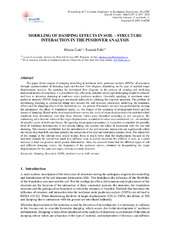Приказ основних података о документу
Modeling of Damping Effects in Soil – Structure Interaction in the Pushover Analysis
| dc.creator | Ćosić, Mladen | |
| dc.creator | Folić, Radomir | |
| dc.date.accessioned | 2023-12-13T08:42:15Z | |
| dc.date.available | 2023-12-13T08:42:15Z | |
| dc.date.issued | 2021 | |
| dc.identifier.uri | http://rims.institutims.rs/handle/123456789/751 | |
| dc.description.abstract | The paper shows aspects of damping modelling in nonlinear static pushover analysis (NSPA) of structures through systematization of damping types and formed flow diagram, depending on the type of applied target displacement analysis. By applying the developed flow diagram, in the process of creating and analysing numerical models of structures, it is possible to very efficiently consider which type of damping should be selected and how to introduce damping in nonlinear static pushover analysis. Generally speaking, in nonlinear static pushover analysis (NSPA) damping is introduced indirectly by reducing the response spectrum. The problem of introducing damping is considered taking into account the soil-structure interaction, modelling the kinematic effects and the damping effects of the foundation, i.e., the ground. Parametric analysis was performed by varying the parameters: the effect of foundation depth, i.e., the impact of the existence of underground floors and the impact of damping. Based on the developed pushover curves, the levels of target displacements for each individual condition were determined, and then these discrete values were classified according to soil categories. By connecting such discrete values of the target displacement, a cumulative curve was constructed, i.e., an envelope of possible states of drifts and forces. By applying the proposed procedure, it is possible to consider the possible level of nonlinear deformations of the system, taking into account the effect of interaction with the soil and damping. The research established that the introduction of the soil-structure interaction can significantly affect the values of global drift, and thus partially the correction of the relevant total lateral seismic force. The sensitivity of the change in the relevant total lateral seismic force is much lower than the displacement, because in the nonlinear domain the system has much less stiffness, even in certain situations the stiffness is zero, so a small increase in load can produce much greater deformation. Also, the research found that for different types of soil and different damping values, the fragments of the pushover curves, obtained by interpolating the target displacements for the same soil types, overlap at certain intervals | sr |
| dc.language.iso | en | sr |
| dc.relation | info:eu-repo/grantAgreement/MESTD/inst-2020/200012/RS// | sr |
| dc.rights | openAccess | sr |
| dc.rights.uri | https://creativecommons.org/licenses/by-sa/4.0/ | |
| dc.source | 1st Croatian Conference on Earthquake Engineering, Zagreb, Croatia | sr |
| dc.subject | damping | sr |
| dc.subject | flowchart | sr |
| dc.subject | NSPA | sr |
| dc.subject | pushover curve | sr |
| dc.subject | drift | sr |
| dc.subject | seismic | sr |
| dc.title | Modeling of Damping Effects in Soil – Structure Interaction in the Pushover Analysis | sr |
| dc.type | conferenceObject | sr |
| dc.rights.license | BY-SA | sr |
| dc.citation.epage | 1344 | |
| dc.citation.spage | 1333 | |
| dc.identifier.doi | 10.5592/co/1crocee.2021.194 | |
| dc.identifier.fulltext | http://rims.institutims.rs/bitstream/id/1626/bitstream_1626.pdf | |
| dc.type.version | publishedVersion | sr |

